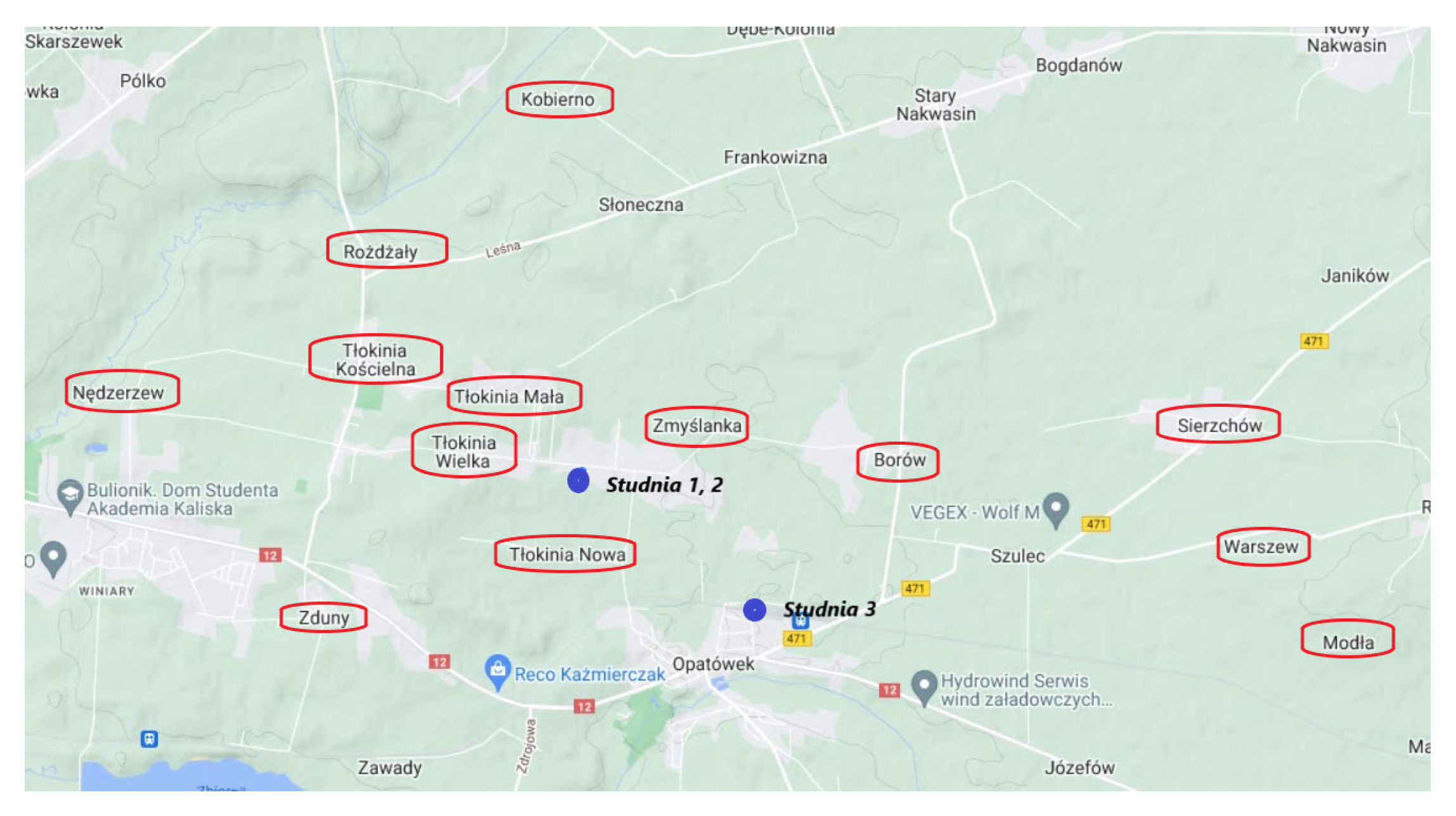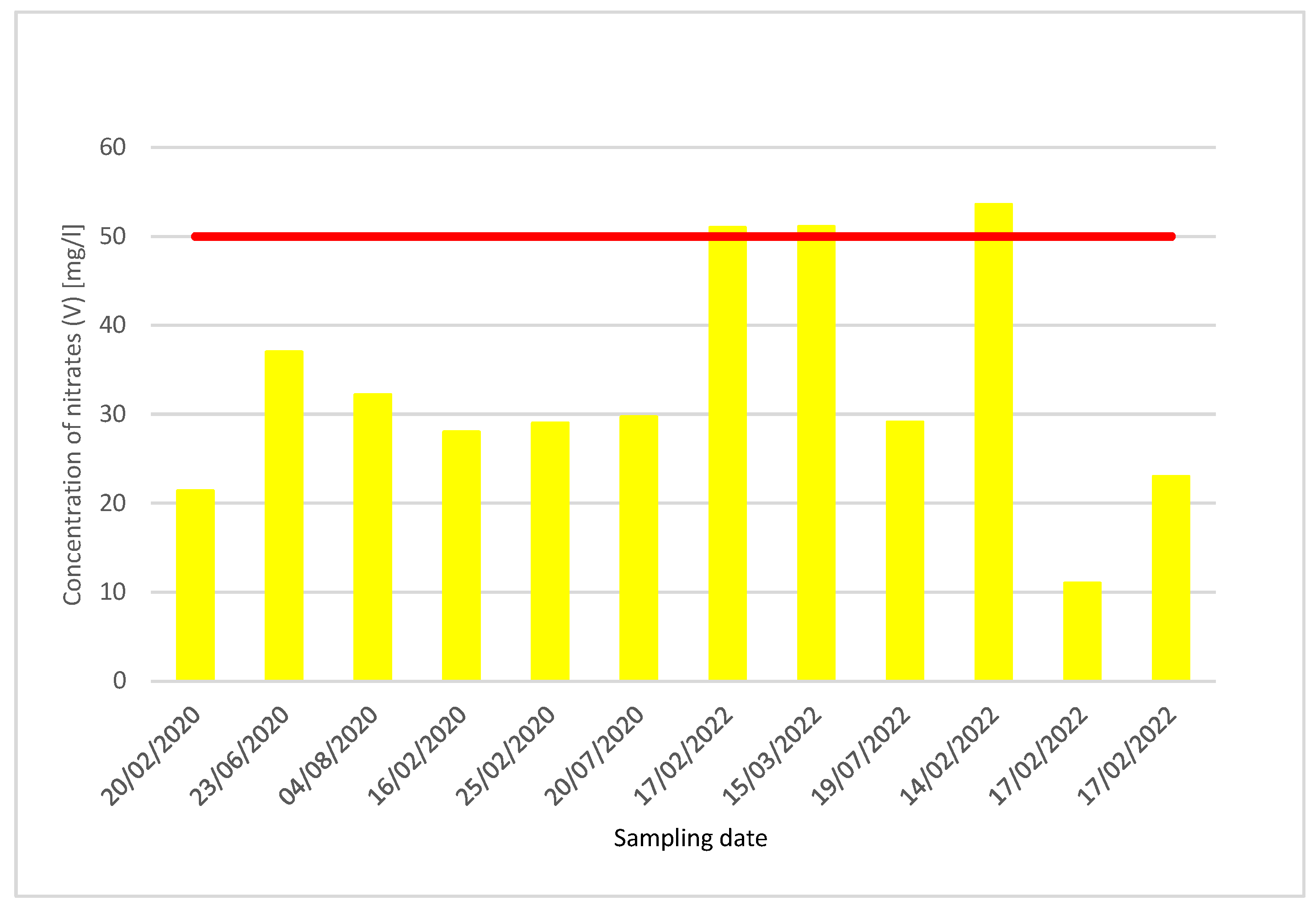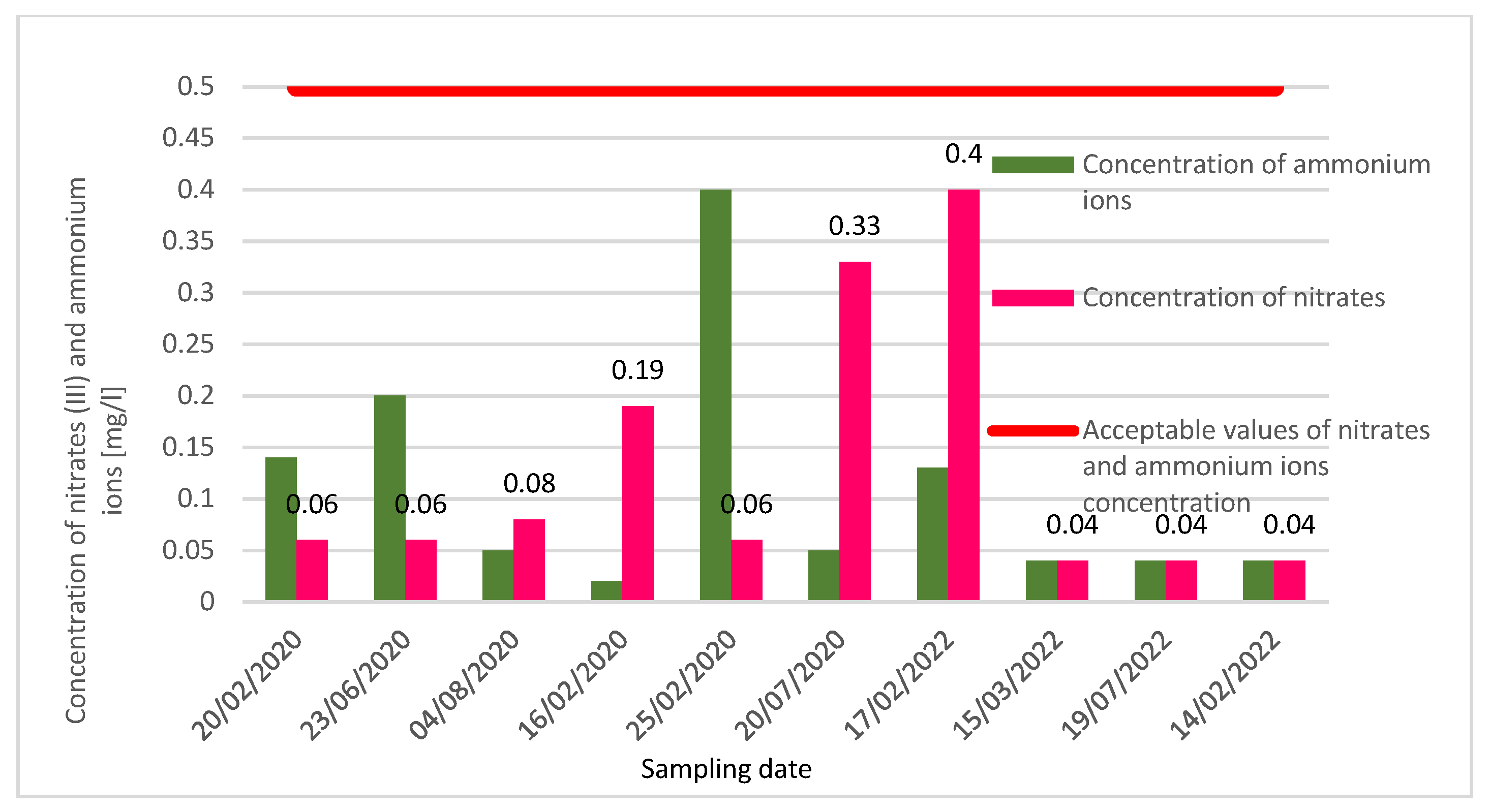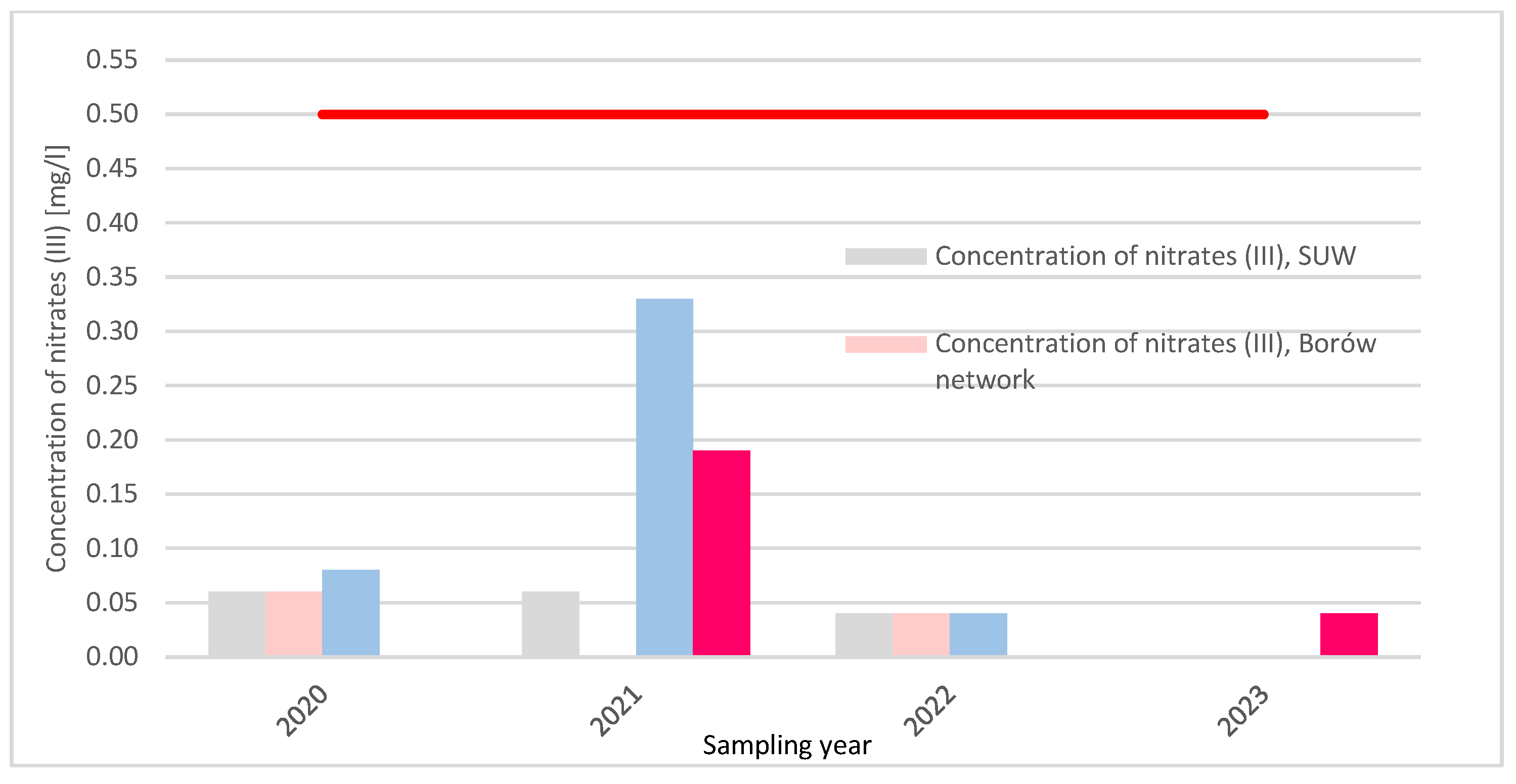Methods of Assessing Water Quality in Terms of Public Health
Abstract
1. Introduction
2. Materials and Methods
2.1. Geographical Characteristics of the Study Area
2.2. Physicochemical Specification of the Water Available in the Area
2.3. Water Intakes and Population Water Demand
2.4. Principle of the Method
2.5. Determinations of Nitrogen Compounds—Ammonium Ions, Nitrates (III and V)
3. Results
4. Discussion
5. Conclusions
- The acceptable values of nitrates (V) were exceeded in 25% of tested samples of tap water from the Tłokinia Wielka water supply network located in the Opatówek commune, Kalisz district, in the southeastern part of Greater Poland;
- Water from the Tłokinia Wielka water supply network periodically does not meet the requirements set forth by the legal regulations. The Municipal Office of Opatówek, which manages the waterworks, took actions to improve the water quality for residents of the areas supplied by the Tłokinia Wielka waterworks; a new deep well was drilled, and preliminary analyses of raw water were carried out. The results are satisfactory—the water does not contain nitrogen compounds.
Author Contributions
Funding
Data Availability Statement
Conflicts of Interest
References
- European Union. Directive (EU) 2020/2184 of the European Parliament and of the Council of 16 December 2020 on the quality of water intended for human consumption (recast). Off. J. Eur. Union 2020, L 435, 1–62. [Google Scholar]
- Regulation of the Minister of Health of 7 December 2017 “On the quality of water intended for human consumption”. Available online: https://isap.sejm.gov.pl/isap.nsf/DocDetails.xsp?id=WDU20170002294 (accessed on 25 December 2024). (In Polish)
- World Health Organization. Nitrate and Nitrite in Drinking-Water: Background Document for Development of WHO Guidelines for Drinking-Water Quality; World Health Organization: Geneva, Switzerland, 2011. [Google Scholar]
- Ward, M.H. Too much of a good thing? Nitrate from nitrogen fertilisers and cancer: President’s cancer panel—21 October 2008. Rev. Env. Health 2009, 24, 357–363. [Google Scholar]
- Schullehner, J.; Hansen, B.; Thygesen, M.; Pedersen, C.B.; Sigsgaard, T. Nitrate in drinking water and colorectal cancer risk: A nationwide population-based cohort study. Int. J. Cancer 2018, 143, 73–79. [Google Scholar] [CrossRef] [PubMed]
- Schullehner, J.; Hansen, B. Nitrate exposure from drinking water in Denmark over the last 35 years. Environ. Res. Lett. 2014, 9, 095001. [Google Scholar] [CrossRef]
- Ward, M.H.; Jones, R.; Brender, J.D.; de Kok, T.M.; Weyer, P.J.; Nolan, B.T.; Villanueva, C.M.; Van Breda, S.G. Drinking water Nitrate and Human Health: An Updated Review. Environ. Res. Public Health 2018, 15, 1557. [Google Scholar] [CrossRef]
- Michalski, R.; Pecyna-Utylska, P.; Kernert, J.; Grygoyć, K.; Klyta, J. Health risk assessment of selected metals through tap water consumption in Upper Silesia, Poland. J. Environ. Health Sci. Eng. 2020, 18, 1607–1614. [Google Scholar] [CrossRef]
- Kluska, M.; Jabłońska, J. Variability and heavy metal pollution levels in water and bottom sediments of the Liwiec and Muchawka Rivers (Poland). Water 2023, 15, 2833. [Google Scholar] [CrossRef]
- Central Statistical Office/Thematic areas/Municipal infrastructure. Real estate/Real estate, buildings, municipal infrastructure/Municipal infrastructure. 2017. Available online: https://stat.gov.pl/ (accessed on 25 December 2024). (In Polish)
- Królak, E.; Raczuk, J. Nitrate concentration-related safety of drinking water from various sources intended for consumption by neonates and infants. Arch. Environ. Prot. 2018, 44, 3–9. [Google Scholar] [CrossRef]
- PN-ISO 5667-5:2017-10/Ap1:2019-07; Water Quality. Sampling. Part 5: Guidance on Sampling of Drinking Water from Treatment Works and Piped Distribution Systems. Polish Committee for Standardization: Warsaw, Poland, 2017.
- Municipal Office of the Opatówek Commune. URZĄD MIEJSKI GMINY OPATÓWEK. GKM.7021.81.2023. 2023. (In Polish) [Google Scholar]
- PN-ISO 7150-1:2002; Water Quality—Determination of Ammonium Nitrogen—Part 1: Manual Spectrometric Method. Polish Committee for Standardization: Warsaw, Poland, 2013. (In Polish)
- PN-EN 26777:1999; Water Quality—Determination of Nitrites—Molecular Absorption Spectrometry Method. Polish Committee for Standardization: Warsaw, Poland, 2013. (In Polish)
- PN-82/C-04576.08; Water and Wastewater. Testing of Nitrogen Compounds-Determination of Nitrate Nitrogen by Colorimetric Method with Sodium Salicylate. (In Polish)
- Municipal Office of the Opatówek Commune. Zestawienie wody 2022. 2022. (In Polish) [Google Scholar]
- Central Statistical Office. Housing and Municipal Infrastructure; Central Statistical Office: Cork, Ireland, 2021.
- Radzka, E.; Rymuza, K.; Jankowska, J. The assessment of drinking water quality using zero unitisation method. Arch. Environ. Prot. 2015, 41, 91–95. [Google Scholar] [CrossRef][Green Version]
- Garboś, S.; Święcicka, D. Human health risk assessment of uranium in drinking water sampled from drilled wells located in rural areas of the Lower Silesian region (Poland). Arch. Environ. Prot. 2015, 41, 21–27. [Google Scholar] [CrossRef]
- Kiryluk, A. Concentration of nitrate (V) in well water in the rural areas of Podlasie Province and the assessment of inhabitants’ health risk. Ecol. Chem. Eng. A 2011, 18, 207–218. [Google Scholar]
- Davidson, E.A.; David, M.B.; Galloway, J.N.; Goodale, C.L.; Haeuber, R.; Harrison, J.A.; Howarth, R.W.; Jaynes, D.B.; Lowrance, R.R.; Nolan, B.T.; et al. Excess nitrogen in the U.S. environment: Trends, risks, and solutions. In Issues in Ecology; Ecological Society of America: Washington, DC, USA, 2012. [Google Scholar]
- USEPA. Regulated Drinking Water Contaminants: Inorganic Chemicals. Available online: https://www.epa.gov/ground-water-and-drinking-water/national-primary-drinking-water-regulations (accessed on 25 December 2024).
- Regulation of the Minister of the Environment on the criteria and method of assessing the condition of groundwater of 23 July 2008. Available online: https://isap.sejm.gov.pl/isap.nsf/DocDetails.xsp?id=WDU20081430896 (accessed on 25 December 2024). (In Polish)
- Taneja, P.; Labhasetwar, P.; Nagarnaik, P.; Ensink, J.H.J. The risk of cancer as a result of elevated levels of nitrate in drinking water and vegetables in Central India. J. Water Health 2017, 15, 602–614. [Google Scholar] [CrossRef] [PubMed]
- International Nitrogen Initiative. Available online: http://www.initrogen.org/ (accessed on 22 April 2018).
- European Commission. The Nitrates Directive. Available online: http://ec.europa.eu/environment/water/water-nitrates/index_en.html (accessed on 10 May 2018).
- European Union (EU). Council Directive 91/676/EEC of 12 December 1991 Concerning the Protection of Waters Against Pollution Caused by Nitrates from Agricultural Sources; European Union (EU): Brussels, Belgium, 1991. [Google Scholar]






| Sampling Date | Sampling Place | Ammonium Ions Concentration [mg/L] with Calculated Uncertainty * | Nitrate (III) Concentration [mg/L] with Calculated Uncertainty * | Nitrate (V) Concentration [mg/L] with Calculated Uncertainty * |
|---|---|---|---|---|
| 25 February 2020 | Borów network | 0.14 ± 0.02 | 0.06 ± 0.01 | 21.4 ± 3.0 |
| 23 June 2020 | Suw | 0.20 ± 0.15 | 0.06 ± 0.01 | 37.0 ± 5.0 |
| 04 August 2020 | Tłokinia Wielka network | 0.05 ± 0.01 | 0.08 ± 0.01 | 32.2 ± 4.6 |
| 16 February 2021 | Rożdżały network | 0.04 ± 0.01 | 0.19 ± 0.02 | 28.0 ± 3.3 |
| 25 February 2021 | Suw | 0.40 ± 0.06 | 0.06 ± 0.01 | 29.0 ± 4.0 |
| 20 July 2021 | Tłokinia Wielka network | 0.05 ± 0.02 | 0.33 ± 0.04 | 29.7 ± 3.5 |
| 17 February 2022 | Suw | 0.13 ± 0.02 | <0.04 (0.04 ± 0.01) | 51.0 ± 8.0 |
| 15 March 2022 | Borów network | <0.04 (0.04 ± 0.01) | <0.04 (0.04 ± 0.01) | 51.1 ± 7.5 |
| 19 July 2022 | Tłokinia Wielka network | <0.04 (0.04 ± 0.01) | <0.04 (0.04 ± 0.01) | 29.1 ± 4.3 |
| 14 February 2023 | Rożdżały network | <0.04 (0.04 ± 0.01) | <0.04 (0.04 ± 0.01) | 53.6 ± 7.5 |
| 17 February 2023 | Suw | - | - | 11.0 ± 1.5 |
| 17 February 2023 | Rożdżały network | - | - | 23.0 ± 3.2 |
| Parameter | Criteria [1] | Ammonium (Nitrogen) Ions | Nitrates (III) | Nitrates (V) |
|---|---|---|---|---|
| Scope of method accreditation * | 0.04–0.50 mg/L | 0.04–0.50 mg/L | 0.2–60.0 mg/L | |
| Correctness | ≤10% | 0.04 mg/L—5.00% 0.06 mg/L—2.33% 0.12 mg/L—2.50% 0.25 mg/L—1.92% 0.40 mg/L—1.90% 0.60 mg/L—0.97% | 0.040 mg/L—2.50% 0.050 mg/L—0.80% 0.060 mg/L—2.33% 0.080 mg/L—2.25% 0.125 mg/L—2.50% 0.150 mg/L—0.32% 0.200 mg/L—0.67% 0.250 mg/L—0.10% 0.500 mg/L—0.16% | 0.2 mg/L—2.00% 0.5 mg/L—2.00% 1.0 mg/L—1.00% 2.0 mg/L—2.60% 4.0 mg/L—2.30% 6.0 mg/L—0.27% 8.0 mg/L—0.58% 20.0 mg/L—0.43% 50.0 mg/L—0.13% |
| Intra-laboratory reproducibility (precision under repeatability conditions) | ≤10% | 0.04 mg/L—6.37% 0.06 mg/L—4.25% 0.12 mg/L—2.37% 0.25 mg/L—0.82% 0.40 mg/L—1.82% 0.60 mg/L—2.43% | 0.040 mg/L—4.88% 0.050 mg/L—3.60% 0.060 mg/L—2.29% 0.080 mg/L—1.37% 0.125 mg/L—0.44% 0.150 mg/L—1.73% 0.200 mg/L—0.82% 0.250 mg/L—0.33% 0.500 mg/L—0.46% | 0.2 mg/L—6.45% 0.5 mg/L—4.79% 1.0 mg/L—1.32% 2.0 mg/L—1.93% 4.0 mg/L—2.63% 6.0 mg/L—0.80% 8.0 mg/L—0.99% 20.0 mg/L—1.57% 50.0 mg/L—0.29% |
| Intermediate precision | ≤10% | 0.05 mg/L—7.07% 0.50 mg/L—2.17% | 0.050 mg/L—4.16% 0.250 mg/L—2.17% 0.500 mg/L—2.66% | 0.3 mg/L—3.88% 6.25 mg/L—2.63% 20.0 mg/L—3.28% 50.0 mg/L—2.59% |
| Repeatability of drinking water sample | ≤10% | 4.67% | 3.47% | 1.94% |
| Limit of detection | - | 0.010 mg/L | 0.002 mg/L | 0.025 mg/L |
| Limit of quantification | 30% of the parametric value | 0.020 mg/L | 0.004 mg/L | 0.050 mg/L |
| Coefficient of variation of the method | 6.68% | 5.41% | 0.43% | |
| Correlation coefficient of calibration curve | ≥0.997 | r2—0.998 | r2—0.998 | r2—0.999 |
| Recovery rate | 90–110% | 0.05 mg/L—99.0% 0.25 mg/L—103.3% 0.45 mg/L—93.0% | 0.050 mg/L—96.2% 0.125 mg/L—102.1% 0.220mg/L—99.2% 0.500 mg/L—100.3% | 0.8 mg/L—96.8 4.0 mg/L—99.5 7.2 mg/L—99.4% 20.0 mg/L—99.5% 50.0 mg/L—100.1% |
| Expanded measurement uncertainty of the method without sampling | NH4+—40% NO2—20% NO3—15% | 20.0% | 9.8% | 13.9% |
| Expanded measurement uncertainty of the method with sampling | 20.4% | 11.8% | 14.1% | |
| (Acceptable) parametric value [1]. | 0.50 mg/L | 0.50 mg/L | 50.0 mg/L |
| Month | Extraction in Well No. 3—Opatówek Ludowa Street [m3] | Extraction in Well No. 1—Tłokinia Wielka [m3] |
|---|---|---|
| January | 6900 | 6240 |
| February | 9086 | 4084 |
| March | 16,938 | 916 |
| April | 19,358 | 1796 |
| May | 24,878 | 8055 |
| June | 24,848 | 11,762 |
| July | 24,482 | 13,477 |
| August | 17,051 | 14,720 |
| September | 10,954 | 11,362 |
| October | 9617 | 9208 |
| November | 8314 | 7632 |
| December | 8068 | 7644 |
| Sum | 180,494 | 96,896 |
| Total extraction in 2022 | 277,390 | |
Disclaimer/Publisher’s Note: The statements, opinions and data contained in all publications are solely those of the individual author(s) and contributor(s) and not of MDPI and/or the editor(s). MDPI and/or the editor(s) disclaim responsibility for any injury to people or property resulting from any ideas, methods, instructions or products referred to in the content. |
© 2024 by the authors. Licensee MDPI, Basel, Switzerland. This article is an open access article distributed under the terms and conditions of the Creative Commons Attribution (CC BY) license (https://creativecommons.org/licenses/by/4.0/).
Share and Cite
Kubisiak-Banaszkiewicz, L.; Żukiewicz-Sobczak, W.; Starek-Wójcicka, A.; Mazur, J.; Sobczak, P. Methods of Assessing Water Quality in Terms of Public Health. Water 2025, 17, 70. https://doi.org/10.3390/w17010070
Kubisiak-Banaszkiewicz L, Żukiewicz-Sobczak W, Starek-Wójcicka A, Mazur J, Sobczak P. Methods of Assessing Water Quality in Terms of Public Health. Water. 2025; 17(1):70. https://doi.org/10.3390/w17010070
Chicago/Turabian StyleKubisiak-Banaszkiewicz, Luiza, Wioletta Żukiewicz-Sobczak, Agnieszka Starek-Wójcicka, Jacek Mazur, and Paweł Sobczak. 2025. "Methods of Assessing Water Quality in Terms of Public Health" Water 17, no. 1: 70. https://doi.org/10.3390/w17010070
APA StyleKubisiak-Banaszkiewicz, L., Żukiewicz-Sobczak, W., Starek-Wójcicka, A., Mazur, J., & Sobczak, P. (2025). Methods of Assessing Water Quality in Terms of Public Health. Water, 17(1), 70. https://doi.org/10.3390/w17010070






